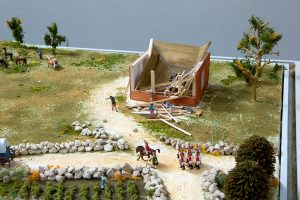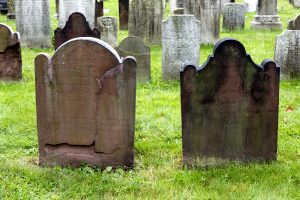Nestled amid factories, automotive shops and diners in an industrial section of southern New York, just a short walk from the Bronx boundary, sits a little-known gem of the American Revolution, St. Paul’s Church. Partially completed at the time of the Revolution, the church served as a hospital first for American soldiers and, after the American loss at Pell’s Point, for British and Hessian troops.[1] Today the site is in the city of Mount Vernon, but this historic structure appears to the passerby much as it did over 240 years ago when Mount Vernon was part of Eastchester, New York.
St. Paul’s Church, originally called the Church at Eastchester, was a central focus of eighteenth-century life in Eastchester. Countywide elections, such as the 1733 contest between Lewis Morris, the favorite of the people, and the royal governor’s preferred candidate William Forster for a seat in the New York provincial assembly, were held on the church’s village green. The Morris-Forster contest drew one of the largest crowds for a political event in colonial America, the particulars of which were famously published in John Peter Zenger’s inaugural New-York Weekly Journal.[2] The 1733 election had long-term significance for the development of religious freedom in early America.
The people of Eastchester began building St. Paul’s in 1763 to replace a small wooden structure residents had used for worship since 1700. The original building, which stood about sixty to eighty yards from the current church, had been built by dissenters who opposed the Church of England. By 1702, however, Eastchester residents were forced by the British Crown to accept the Anglican religion.[3] This new church was inspired by those built in London in the mid-seventeenth century—the principal architect at the time being Christopher Wren—and depended on sketches and diagrams of English churches.[4] Local masons and craftsmen used stones from surrounding fields (hence the term fieldstone), while bricks were likely molded from clay deposits along the Hudson River.
On June 25, 1767, The Reverend Samuel Seabury, then rector of the parish Church of Westchester, which included the Church at Eastchester, wrote:
At Eastchester, which is four miles distant, the congregation is generally larger than at Westchester [town]. The old church in which they meet, as yet, is very cold. They have erected and just completed the roof of a large well-built stone church, on which they have expended, they say, £700 currency, but their ability seems exhausted, and I fear I shall never see it finished.[5]
On the eve of the American Revolution, when construction was halted, most of the exterior had been completed with only about a third of the tower left unfinished. One can detect a slight difference in the brick used to complete the tower when building was resumed after the war. The interior was largely unfinished with only a dirt floor in 1776.
From that time and for much of the war, the church was used as a hospital. After the disastrous Battle of Brooklyn on August 27, 1776, Gen. George Washington realized that he would soon need to evacuate Manhattan and move his troops north.[6] The Church at Eastchester was chosen as the logical location for a medical facility. Dr. John Warren, one of the Continental army’s leading physicians, assumed the post as its first medical director in the fall of 1776, but within weeks became ill and was replaced by Dr. John Morgan, who wrote to Warren on October 4, 1776, that he was “improving the Church at Eastchester into a hospital.”[7] Morgan’s tenure was also short-lived, because the British took over the makeshift hospital after the American loss at the Battle of Pell’s Point on October 18, 1776. This battle was fought only about a mile from the Church at Eastchester.
Anticipating the British occupation, American troops quickly removed what medical and other supplies they could before the arrival of the enemy. The bronze church bell, which had been cast in London at the same foundry as Philadelphia’s Liberty Bell and which at that time was hanging in the wooden meeting house, was buried, according to historian Otto Hufeland, “probably quite as much from fear that it would share the fate of the door knockers (American troops had cast into cannon brass door knockers from hundreds of country houses), as that it would be taken by the British, who brought their cannon and ammunition from England.”[8]

When the opposing army reached the Church at Eastchester with wounded British and Hessian soldiers, they dismantled the original wooden church for firewood and treated the wounded on the dirt floor of the new stone church. One Beldart, an aged Eastchester sexton, remembered “you could trace blood stains on the floor.”[9] Another authority of the period commented, “The sufferings here endured, and the many deaths within its walls would, independent of its subsequent consecration, diffuse around it all the odor of sanctity.”[10] At least five Hessian soldiers died and were buried in the sandpit that had been used to make mortar for the construction of the church.[11]
After the war, the church was completed in 1788 and officially named St. Paul’s Episcopal Church in 1795, although it was not consecrated until 1805. The bell, which had been buried at the time of the Battle of Pell’s Point, hangs in the church steeple today. Because it had been cast for the much smaller wooden structure, it is undersized for the new church. St. Paul’s served as a place of worship until 1980, at which time ownership was transferred to the National Park Service.
The cemetery, a five-acre site behind the church, is the burial place of notables from this period, including family members who had split loyalties during the war, such as Stephen Ward, a Patriot, and his brother and sister-in-law, Edmund and Phebe Ward, who were Loyalists, and Jonathan and Theodosius Fowler, Loyalist father and Patriot son, respectively. Jonathan Fowler, a prominent Eastchester citizen and Westchester County judge, must have been enraged when his son joined the American army in March 1776 and fought on the American side in the battles of Long Island, Saratoga, Monmouth, and Yorktown.[12]
Today, St. Paul’s Church and cemetery are open to the public. Guided walks over the very grounds where the Pell’s Point battle was fought are held several times a year and periodic tours of the church and cemetery are given. Plaques on the eighteenth-century tall-walled pews identify the pews’ occupants in that era. Their height was necessary to accommodate use of the building in the winter when small rectangular foot warmers filled with embers provided the only heat. These were placed on the floor of the pews where the high walls helped to contain the heat. Pews were assigned according to the amount of money a family donated to the church with those making the highest donations seated in the front of the church closest to the pulpit. In 1833, George Rapelje, an original pew holder, commissioned Henry Erben to make a pipe, or pump, organ for the church. It remains one of the oldest working pipe organs in the United States.[13]

Programs related to the church’s history are held throughout the year. Especially poignant is the celebration held every Fourth of July on the same village green as the 1733 election. Its simplicity only adds to its impact. Visitors facing the centuries-old church listen to a jazz band play patriotic songs before the posting of colors and short addresses by local politicians, the site manager, and a keynote speaker. The highlight of the program is the reading of the Declaration of Independence by John Banning from a tattered history book that has been used by a member of the Banning family for over 136 years. As the names of the fifty-six signers of the Declaration are read, the church bell tolls thirteen times in honor of the original thirteen states. The solemnity of the reading coupled with the bell’s tolling transports one to that most momentous time in American history.
How fortunate that St. Paul’s Church has been preserved so that today one can sit in the pews and walk among the tombstones of individuals who played a key role in Eastchester during the Revolutionary period.
[1]James Bolton, Brook Farm:The Amusing and Memorable of American Country Life(London: Wetheim, Macintosh, and Hunt, 1859), 14.
[2]New-York Weekly Journal, November 5, 1733, 2-4.
[3]“St. Paul’s Church History,” National Park Service, U.S. Department of the Interior, www.nps.gov/sapa/learn/historyculture/st-pauls-church-history.htm; Eastchester Town Records, Book 3, 33.
[5]Robert Bolton, The History of the Several Towns, Manors, and Patents of the County of Westchester from its First Settlement to the Present Time, C.W. Bolton, ed. (New York: Chas. F. Roper, 1881), 1: 235.
[6]See Council of War, August 29, 1776, in The Papers of George Washington, Revolutionary War Series, 6: 153-55.
[7]Edward Warren, M.D., The Life of John Warren, M.D., Surgeon-General During the War of the Revolution (Boston: Noyes, Holmes, and Company, 1874), 104-05.
[8]Otto Hufeland, Westchester County During the American Revolution, 1775-1783 (Harrison, NY: Harbor Hill Books, 1982), 99.
[10]J. Thomas Scharf, History of Westchester County, New York, Including Morrisania, Kings Bridge, and West Farms, Which Have Been Annexed to New York City (Philadelphia: L.E. Preston & Co., 1886), 2: 751.
[11]David Osborn, “The Hessians,” National Park Service, U.S. Department of the Interior, October 2007, www.nps.gov/sapa/learn/historyculture/upload/The%20Hessians.pdf.
[12]Hufeland, Westchester County, 87. According to Hufeland, three of Jonathan Fowler’s sons, Jesse, Joseph and Theodosius, joined the American army.





Recent Articles
Lydia’s Tale: The Mystery of Lydia Darragh, Irish Quaker, Patriot Spy
Lt. Elijah Evans of Maryland: Unresolved Promotion in an Extra Continental Regiment
A Journey North: Jefferson, Madison, and the Forging of a Friendship
Recent Comments
"The Evolution of the..."
This article is a gem. Sparkling. Excellent research. Wide and deep. Thank...
"The Evolution of the..."
A very interesting article, thank you! A more general question, if you...
"The Evolution of the..."
Thoroughly researched and a succinct presentation, especially given the article's breadth.